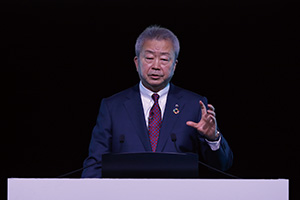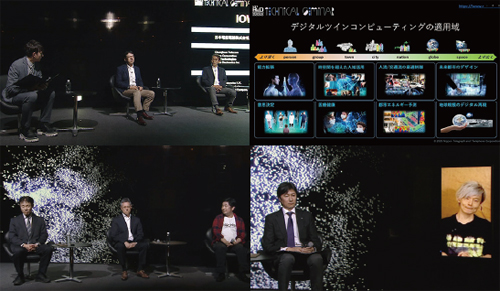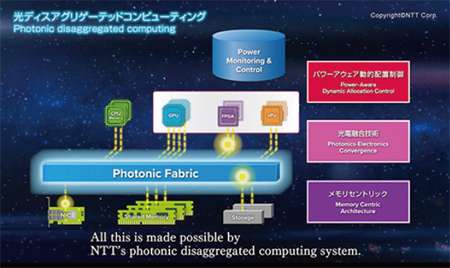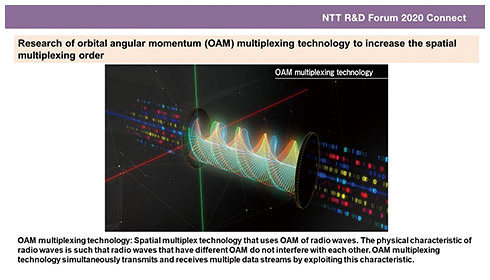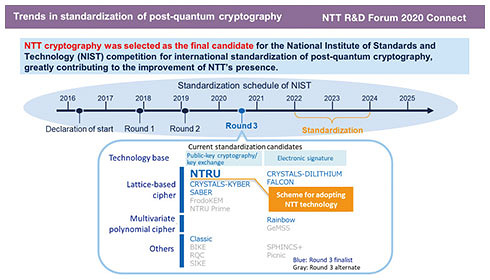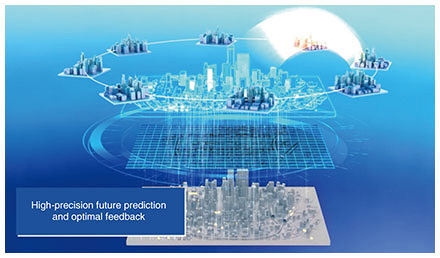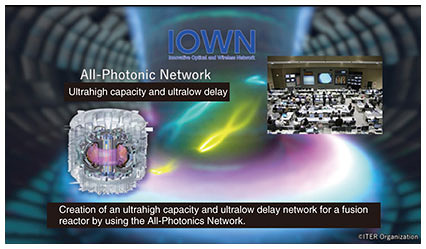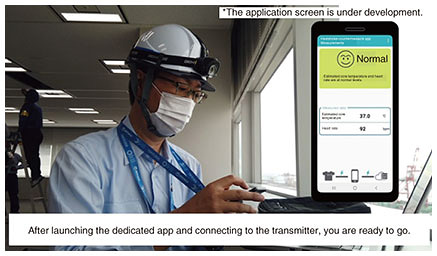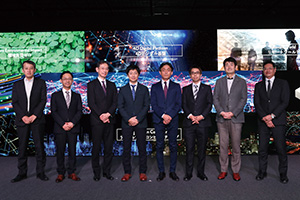 |
|
|
|
|
|
Information Vol. 19, No. 2, pp. 73–82, Feb. 2021. https://doi.org/10.53829/ntr202102in1 Report on NTT R&D Forum 2020 ConnectAbstractNTT R&D Forum 2020 Connect was held online for four days from November 17–20, 2020. This article overviews the forum and gives examples of the technologies presented under the eight main set themes. Keywords: R&D forum, IOWN, Digital Twin Computing 1. Overview of forumThe NTT Group is striving to resolve social issues and to be a value partner that continues to be selected by customers. To actualize the concept of the Innovative Optical and Wireless Network (IOWN) announced in May 2019, we have been working to create an information-communication infrastructure that supports sustainable growth by achieving large-capacity, low-latency, and low-power-consumption networks using photonics technology. The forum, which was held online for the first time in November 2020, presented the latest research results in an easy-to-understand manner through lectures, special sessions, technical seminars, and exhibitions under the theme of “Into the IOWN – Change the Future.” 2. Keynote lectures and special sessionsOn November 17th, Jun Sawada, President and CEO of NTT, gave a keynote lecture entitled the “Road to IOWN” (Photo 1). At the beginning, President Sawada explained that the purpose of making NTT DOCOMO a wholly owned subsidiary of NTT is to strengthen NTT DOCOMO so that it can compete with platformers and other over-the-top service providers. He also stated that this change should lead to the growth and development of the entire NTT Group.
Next, he described the history of pandemics and hegemony and pointed out that we should bear the historical perspective in mind when considering what kind of world is waiting for us in the post-coronavirus society. He then discussed the issues facing the Japanese information technology (IT) industry from the viewpoint of the technology trade balance and went on to talk about the Remote World, i.e., decentralized society and new glocalism as trends in the post-coronavirus society. After introducing messages from President Takashi Niino of NEC Corporation and President Akio Toyoda of Toyota Motor Corporation, he explained the roadmap to the implementation of IOWN and his intension of making IOWN a game changer in the post-coronavirus society. He also talked about Digital Twin Computing, All-Photonics Network, and photonics-electronics convergence devices. He concluded the lecture by declaring that NTT will move ahead with research and development (R&D) and business activities to change the world for the better in the future. On November 18th, Katsuhiko Kawazoe, Executive Vice President and head of Research and Development Planning Department, NTT, presented a keynote lecture introducing the latest R&D trends and prospects under the title of “Into the IOWN – Breakthrough Innovations –” (Photo 2). He talked about the unknown risks that humankind bears, overcoming the power-consumption issue that confronts computers today, heat problems that limit their performance, and importance of digitalization to create new value that is needed at a particular time. After describing the progress made in regard to IOWN, he introduced the development of ultrahigh-speed optical logic gates, photonic direct communication technology, Extreme NaaS (Network as a Service), and data-centric computing infrastructure.
He also presented various services provided by IOWN, such as future prediction that will make our lives more fulfilling, lightning-charging technology, and the 4D digital platformTM. While introducing messages from Kenichi Kurihara, Director General, Naka Fusion Institute, the National Institutes for Quantum and Radiological Science and Technology (QST), Kazuo Ishizuka, President of MTI Co., Ltd., and Masatoshi Harigae, Director General of Research and Development Directorate at the Japan Aerospace Exploration Agency (JAXA), he enthusiastically talked about globalization of R&D activities and space-related initiatives as new challenges for further expanding the field of R&D. Special session 1, delivered on November 19th, welcomed guests Yuki Ota, President of the Japan Fencing Federation and Vice President of the International Fencing Federation and Haruyuki Moroishi, CEO and CCO of IMAGICA EEX Inc. and General Producer of IMAGICA GROUP. The session was moderated by Shingo Kinoshita, Executive Research Engineer, NTT Service Evolution Laboratories, on the theme “Sports & Live Entertainment Viewing Re-imagined in the Post-corona Era.” During the session, he and the guests discussed the current conditions and future of sports and live entertainment during the novel coronavirus pandemic (Photo 3).
Special session 2, delivered on November 20th, welcomed novelist Yuya Takashima, the science fiction consultant for “Mobile Suit Gundam: THE ORIGIN” and the multitalented entertainer Kaori Manabe as guests. Yuji Maeda, Vice President of NTT Space Environment and Energy Research Laboratories, moderated the session on the theme “Challenges of NTT Space Environment and Energy Laboratories in the Coming Space Millennium” (Photo 4). This session introduced various research challenges tackled by the Laboratories, such as optimal operation technology for fusion reactors, while referring to the world in which the science-fiction work Gundam is set.
3. Technology seminarsThe technical seminars were held every day for four days from November 17th to 20th. As well as introducing the cutting-edge research results that NTT has been obtaining, the purpose of the seminars was to give a sense of what NTT is working on, the future we are envisioning, and the efforts we are making toward the future (Photo 5).
On November 17th, a seminar was held on the theme “Into the IOWN – Beyond Human” by Masahisa Kawashima, Vice President and head of the IOWN Promotion Office, Research and Development Planning Department, NTT, and Katsutoshi Ito, General Manager and head of Connectivity Technologies, R&D Center, Sony Corporation. “Beyond humans” is one concept of IOWN for advancing artificial intelligence (AI) capabilities closer to those of humans and further beyond. They introduced a technology of the “next-generation data hub,” which extracts and delivers only the necessary parts from information captured with sensors to keep the AI-processing time within 0.1 seconds, the speed of human response. In relation to another concept of IOWN, namely, the “Remote World,” they introduced a “remote spectator assistance system,” which was developed from joint research between Sony and NTT, and the technology that supports it. Using ultralow-latency IOWN, the system creates a virtual space in which remote spectators can share a sense of enthusiasm beyond the barrier of distance. On the theme “Into the IOWN,” “photonic disaggregated computing,” which ensures high efficiency and low power consumption, and “Extreme NaaS,” which keeps people connected to the network comfortably, were introduced as technologies that embody IOWN. On November 18th, a seminar entitled “Beyond Digital Twin—Digital Twin Computing” was held by Takao Nakamura, Director of NTT Digital Twin Computing Research Center, and Michiaki Matsushima, Editor-in-Chief of “WIRED” Japan. Digital twins, which are mappings of things and people posted to the digital world, are currently being developed separately in each industrial domain. In this seminar, they explained the concept of Digital Twin Computing, which is a computing paradigm that creates a variety of virtual societies by integrating various types of digital twins. They also introduced high-precision and real-time vehicle-position data collection technology that reduces traffic congestion and five themes concerning R&D initiatives toward development of human digital twins, namely, “technology for modeling outer and inner surfaces,” “technology for understanding,” “technology for thinking,” “technology for expressing,” and “technology for reproducing a group of people.” It was mentioned that more multi-faceted approaches, such as brain science, psychology, and behavioral economics, will be needed in the future. In the latter half of the seminar, four grand challenges were announced, namely, “Mind-to-Mind Communication,” “Another Me,” “An Exploring Engine for the Future Society,” and “Inducing Inclusive Equilibrium Solutions for the Earth and its Social and Economic Systems.” Takao Nakamura declared that he and his co-researchers will continue to carry out cutting-edge research with a wide range of variations. On November 19th, a seminar was held by Yoshiaki Nakajima, Senior Research Engineer, NTT Secure Platform Laboratories, Takafumi Hamano, Senior Research Engineer, NTT Network Technology Laboratories, and Tatsuya Hayashi, Researcher at KMD Research Institute, Keio University, and board member and Chief Technology Officer of the security company Parongo, on the theme of “Safe and Secure Social Infrastructure for Smart World.” It is expected that an unprecedented smart world in which both the physical space and cyberspace are fused will be created by analyzing data about not only things but also humans in cyberspace and feeding those analysis results back to the physical space. In such a world, however, since various equipment and systems are connected to the network, the number of attacks will increase and the damage from such attacks will be amplified. Therefore, a new proactive approach of cybersecurity technology is required instead of the conventional reactive approach. To meet this need, NTT has developed a technology—which was introduced in the seminar—that captures the composition and state of things and people in cyberspace and analyzes them spatially and temporally. This analysis makes it possible to detect the spread of infection across domains and to identify the signs and causes of infection. Using smart agriculture as an example, the hosts then introduced certificate-based authentication technology for Internet of Things (IoT) devices, to prevent leakage of valuable cultivated expertise and obstruction of that cultivation due to unauthorized distribution of control information. They also introduced the idea of a “dedicated core network,” which enables ultralow-latency communication even when the number of connected devices and communication volume are expected to increase due to the popularization of 5th-generation mobile communication system (5G) services. On November 20th, a seminar entitled “Contributing to a Healthy and Hopeful ‘Medical and Healthcare Future’ – ICT and Well-being, Human Co-being –” was held by Katsuyoshi Hayashi, Chief Producer, Research and Development Planning Department, NTT, and Professor Hiroaki Miyata of the Faculty of Medicine, Keio University. Immediately before the seminar, NTT announced “Medical and Health Vision: Realization of a Bio Digital Twin.” This seminar explained the content of this vision and introduced research from the following three perspectives: (i) “obtaining data,” a technology that visualizes trends in blood glucose by irradiating radio waves acquired from a wearable sensor device, (ii) “behavior feedback,” a technology that analyzes myoelectric signals and feeds analysis results back to the user; and (iii) “predicting the future,” a technology for creating an image of one’s future in the digital world, reviewing one’s current behavior, and helping one to reach a better future. These technical seminars demonstrated the initiatives of NTT R&D and the NTT Group, which received favorable reviews from online audiences. 4. Exhibition of R&D resultsThe Forum set up eight exhibition themes, “[Special Category] IOWN Key Technologies,” “Networks,” “AI,” “Security,” “Data Utilization and Management,” “Media and Devices/Robotics,” “Environment and Energy,” and “Basic Research,” and the latest R&D results (83 in total) concerning those themes were showcased in a virtual exhibition space. The exhibition presented the technologies that the NTT Group is working on, the results of collaborations with partner companies, and a wide range of technologies—from technologies developed in basic research fields to commercialized technologies. 4.1 IOWN Key TechnologiesThe key technologies in the technology-development roadmap formulated to implement IOWN were exhibited along with expected new user experiences (Fig. 1). “All-Photonics Network with High Scalability and Flexibility (I01)” introduced the latest technology for creating new customer experiences, such as remote production and infrastructure sharing, by dynamically providing a large-capacity optical path that can accommodate various protocol stacks. This technology presents the possibilities of a new world created by optical interfaces and large-capacity optical paths. “Photonic Disaggregated Computing (I05)” explained the latest technology for efficiently using computing resources (such as central processing units, graphics processing units, and field-programmable gate arrays) to improve power efficiency of datacenters by closely connecting such resources with photonics-electronics convergence.
4.2 NetworksInnovative optical/wireless network technologies and advanced control/operation technologies that will create a smart social infrastructure were exhibited. “OAM-MIMO Multiplexing Transmission Technology (N04)” introduced a terabit-class wireless transmission technology for handling increasing wireless traffic in the era beyond 5G (Fig. 2). “Unified Technologies for Driverless Robotic Farm Machines (N06)” featured technology for safe and efficient autonomous driving of robotic farm machines by remote monitoring and control as well as IOWN elemental technologies, such as prediction of wireless quality, overlay networking, video streaming, image analysis, and network-cooperative device actuation.
4.3 AIThe NTT Group’s AI-related technology called “corevo®”—which makes people’s lives more fulfilling and creates new value by supporting the activities of people and society—was exhibited (Fig. 3). “Digital Twin Computing Technology (A01)” explained Digital Twin Computing, an element of IOWN, and an envisioned world in which the real world is fused with the highly interactive virtual societies through human digital twins. “Media Processing Device Technology in the Remote World Era (A15)” presented a technology for precisely controlling the sound space around the user to create a “personalized sound zone” that delivers only the sounds that the user wants to know and hear. “Asynchronous Distributed Deep Learning for Edge Computing (A20)” introduced a method for securely training a machine-learning model by using distributed storage (edge-computing environment) in contrast to the current deep learning method that involves training a model from data aggregated in one location.
4.4 SecuritySecurity technology that appropriately protects the smart world from complicated cyberattacks and supports secure data distribution and utilization and future cryptographic technology (Fig. 4) were exhibited. “NTT Post-quantum Cryptography (S05)” introduced NTT’s next-generation cryptography, which is in the final selection stage of the international standardization contest. It is a basic public-key encryption technology that cannot be broken even with quantum computers.
4.5 Data Utilization and ManagementA technology for processing huge and complex data at high speed and enabling multiple parties to freely use the data across industry and regional barriers was exhibited (Fig. 5). “Data Analysis Technology for Digital Transformation (DX) (D02)” explained a technology for implementing DX of customer contact operations during the novel coronavirus pandemic. This technology enables integrated data utilization and analysis that improves productivity of workers and customer convenience in customer contact points at government offices, financial institutions, etc. “Overview of 4D Digital Platform (D06)” displayed an overall picture of the 4D digital platformTM, which integrates various sensing data in real time on the “advanced geospatial information database,” which is highly accurate and has abundant semantic information.
4.6 Media and Devices/RoboticsTwo technologies were introduced: (i) a virtual-reality/augmented-reality technology that creates a new life environment for creating a society that makes the most of the abilities of a person by using data from cyberspace and (ii) a human-machine-interface technology that seamlessly connects everything (Photo 6). “Cybernetics Technology to Augment Human Capabilities (M01)” presented a technology for augmenting human motor skills by acquiring and analyzing biological signals and providing feedback to help people improve their motor skills and become who they want to be. “Remote Spectator Assistance System (M02)” showcased a technology for enhancing the sense of excitement and unity and stimulating interaction between spectators during remote viewing of sports and concerts and a technology for creating a space where remote spectators can share their enthusiasm beyond distance.
4.7 Environment and EnergyEnvironmental and energy technologies that will revolutionize the future of the global environment with the aim of regenerating the global environment and creating a sustainable and inclusive society was exhibited (Fig. 6). “Optimal Operation Technology for Fusion Reactors (E02)” introduced a technology that will help the International Fusion Experimental Reactor (ITER) project achieve stable operation of nuclear fusion by enabling the construction of a network that can transmit various sensor data from a fusion reactor to the control center at ultrahigh speed and low delay and feed that data back to actuators by using IOWN technology (i.e., All-Photonics Network and Digital Twin Computing). In the future, we plan to use Digital Twin Computing to reproduce fusion reactors in cyberspace through advanced simulations. “Lightning Control and Charging Technology (E03)” described study of a technology that controls lightning to protect people and equipment from lightning strikes and utilization of lightning energy in anticipation of an era of heavy lightning.
4.8 Basic ResearchBasic research that will bring about change in society was exhibited. It included R&D of innovative information-processing technology, advanced device technology, materials technology, and medical and biotechnology. “Wearable Stethoscope for Remote Auscultation (B01)” introduced a technology for supporting online medical care and self-care. By embedding a large number of acoustic sensors into an examination gown, multi-faceted high-quality sounds associated with biological activities of the wearer can be simultaneously transmitted to a receiving terminal in a remote location, and it is possible to convert (visualize) information, such as generation of videos showing the movement of the heart from sounds and creation of sentences about findings. “Heat-related-health-hazards Prevention System (B02)” featured a technology for remotely monitoring workers equipped with wearable biological and environmental sensors and estimating and alerting each individual to the risk of heatstroke (Fig. 7).
5. After the forumThis was the first time that the forum was open to the public online, and it was viewed by more than 20,000 people. Since this event was an online forum, a large number of the general public participated, in addition to the group employees who were invited to attend. We found that people had expectations concerning NTT’s R&D from questionnaires and inquiries after the forum was held. To meet these expectations, we will make even greater efforts regarding basic research and R&D of new technologies.
|
|









